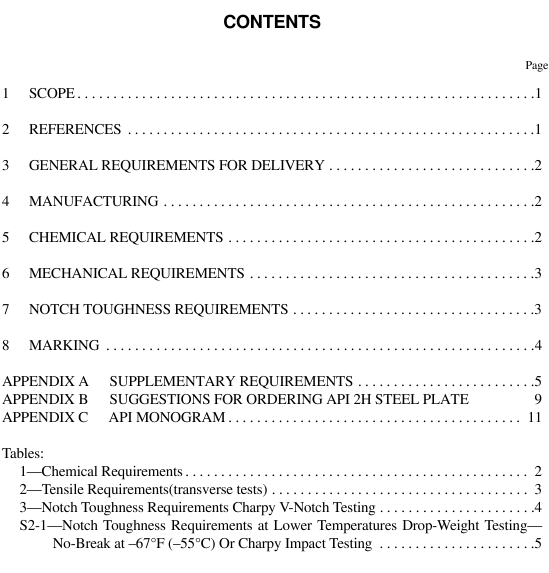API SPEC 2H pdf download

API SPEC 2H pdf download Specification for Carbon Manganese Steel Plate for Offshore Structures
1 Scope 1.1 This specification covers two grades of intermediate strength steel plates up to 4 in. thick for use in welded construction of offshore structures, in selected critical portions which must resist impact, plastic fatigue loading, and lamellar tearing. These steels are intended for fabrication primarily by cold forming and welding as per API Spec 2B. The welding procedure is of funda- mental importance and it is presumed that procedures will be suitable for the steels and their intended service. Conversely, the steels should be amenable to fabrication and welding under shipyard and offshore conditions. API Specifications 2W and 2Y cover companion steels providing similar mechanical properties but with the advantage of potentially lower preheats, and the availability of API RP 2Z prequalification of HAZ toughness. This improvement results from a reduction in the maximum allowed chemical composition and is made possible by changes in the method of heat treatment and/or processing.
1.2 The primary use of these steels is in tubular joints, stiffened plate construction, and other intersections where portions of the plates will be subjected to tension in the thickness direction (Z-direction). Supplementary Requirement S4 provides for through- thickness (Z-direction) testing of the plates by the material manufacturer and specified limits for acceptance. Supplementary Requirement S1 provides for ultrasonic examination of the plates by the material manufacturer and specifies limits for accep- tance. For applications where through-thickness properties are desirable but the expense of extra testing is not considered neces- sary, Supplementary Requirement S5 provides a low-sulfur chemistry intended to reduce the size and number of sulfide inclusions in the plate. Supplementary requirement S5 is neither a substitute for S4 Through-Thickness Testing nor a guarantee of a minimum level of through-thickness ductility. Experience indicates, however, that tests of low-sulfur carbon-manganese steels would usually show at least 20% reduction-of-area in a Z-direction tension test. Even without S5, API Spec 2H provides a reduced sulfur level, compared to other common structural steels.
1.3 The notch toughness requirements specified in Section 7 or S12 are suitable for application below water or above water in areas of temperate climate [14°F (–10°C) minimum service temperature]. Cold-formed materials have less toughness due to straining than that of the original flat plate, especially in those areas aged by the attachment welding of stubs or braces. The requirements for plates in Section 7 include a moderate adjustment for losses in toughness due to straining and aging; however, differences in composition or fabrication practices may result in significantly greater degradation than that included. Supplemen- tary Requirements S7 and S8 deal with the strain-aging problem, and consideration should be given to invoking S7 and/or S8 when the strain exceeds 5% or when (Nitrogen x % strain) exceeds 0.040. Supplementary Requirement S8 provides for testing at the specific temperatures and strain levels of interest and is recommended for all material purchases which exceed the purchaser’s experience base. For applications with lower service temperatures, lower test temperatures should be considered. Supplementary Requirement S2 provides for impact tests at temperatures other than those specified in Section 6 or S12. S2.1 provides for Drop Weight or Charpy V-notch testing at –76°F (–60°C). S2.2 provides for such testing at temperatures less than –40°F (–40°C) but other than –76°F (–60°C).
2 References
The standards referenced herein are as follows:
API
Spec 2B Fabrication of Structural Steel Pipe
ASTM 1
A6/A6M Standard Specification for General Requirements for Rolled Structural Steel Bars, Plates, Shapes, and Sheet Piling
A20/A20M Standard Specification for General Requirements for Steel Plates for Pressure Vessels
A370 Standard Test Methods and Definitions for Mechanical Testing of Steel Products
A578/578M Standard Specification for Straight-Beam Ultrasonic Examination of Plain and Clad Steel Plates for Special Applications









